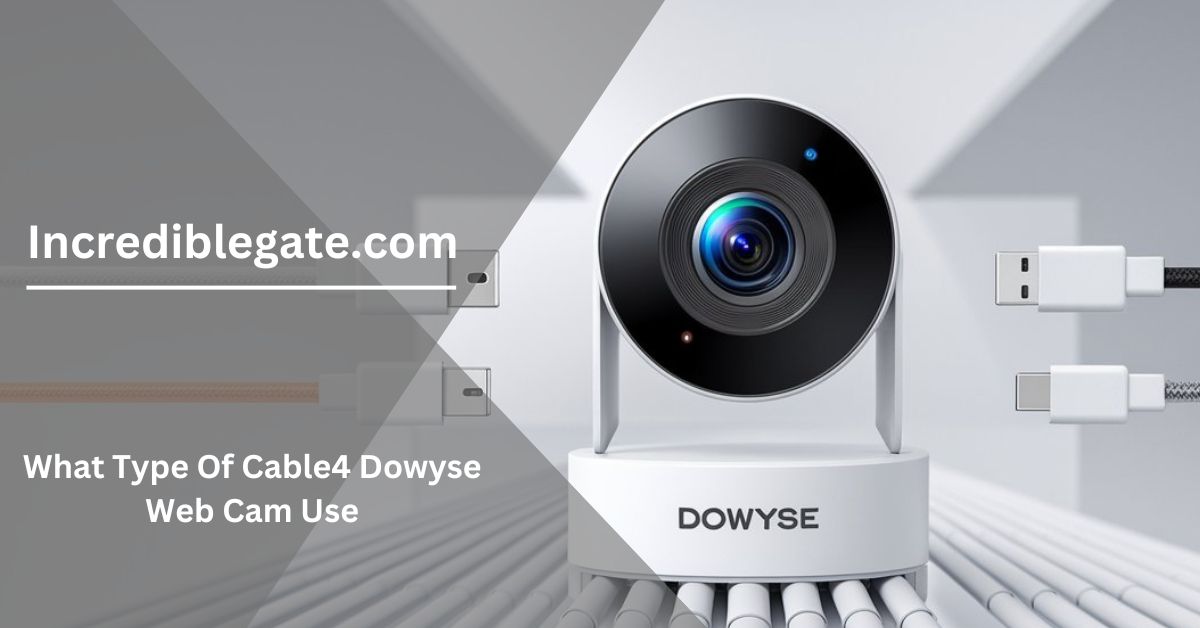In today’s digital world, webcams are indispensable for communication, content creation, and remote work. Dowyse is a brand that has become well-regarded for its high-quality and dependable webcams. A common question that often arises is, “What type of cable does a Dowyse webcam use?”
This detailed guide will explore this question thoroughly, offering insights into the different cable types used by Dowyse webcams and their importance. Additionally, we’ll cover practical tips to ensure you get the most out of your webcam setup.
What Is Dowyse Webcams? – An Overview!
Dowyse webcams are popular for those looking to enhance their video communication experience. They offer a range of models that cater to different needs, from casual video calls to professional streaming. Notably, these webcams are known for their affordable pricing while still delivering decent video quality.
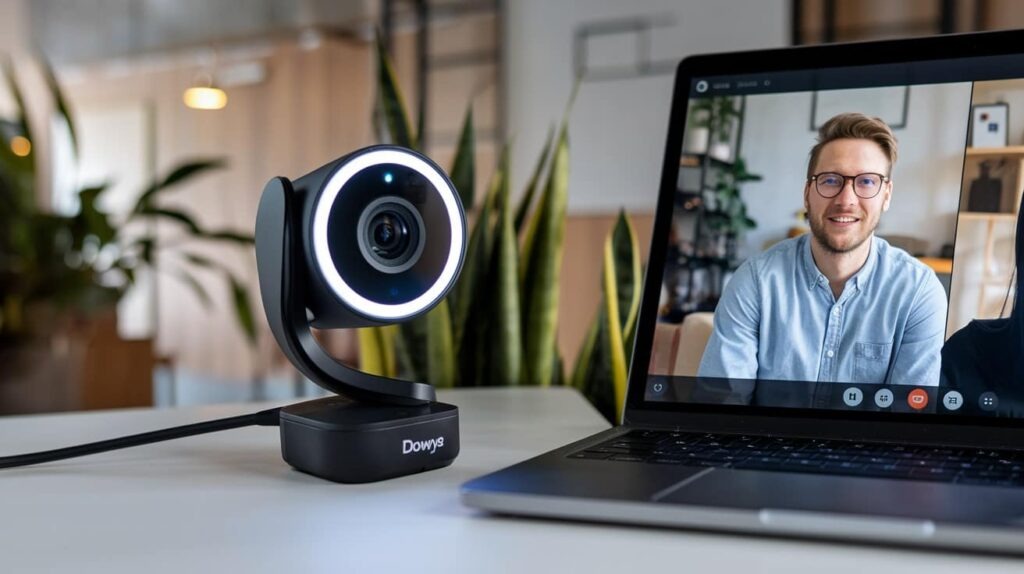
For instance, many Dowyse webcams connect easily to computers via USB, making them user-friendly for anyone, regardless of technical skill. Additionally, they often come with features like adjustable mounts and compatibility with various video conferencing applications, which adds to their convenience. Overall, Dowyse webcams provide a great balance of quality and value, making them a solid option for anyone needing a reliable webcam.
The Importance Of Webcam Cables In Dowyse Products – Lets See!
Webcam cables play a crucial role in the performance of Dowyse webcams. Here are some key points to consider:
- Connection Quality: The right cable ensures a stable connection between the webcam and your computer. A good quality USB cable minimizes interruptions, allowing for smooth video streaming.
- Data Transfer Speed: Different cables support varying data transfer speeds. For instance, using a USB 3.0 cable can significantly improve video quality compared to a slower USB 2.0 cable, making your video clearer and more professional.
- Power Supply: Webcam cables also provide power to the device. A reliable cable ensures the webcam receives consistent power, essential for optimal performance during long video calls or streams.
- Compatibility: It’s important to use the correct cable type for your specific Dowyse webcam model. This ensures compatibility and helps avoid potential issues from using an incorrect or damaged cable.
Common Types Of Cables Used By Webcams – You Must Read!
When it comes to webcams, understanding the common types of cables used can greatly enhance your experience. Here’s a breakdown of the main cable types you should know about:
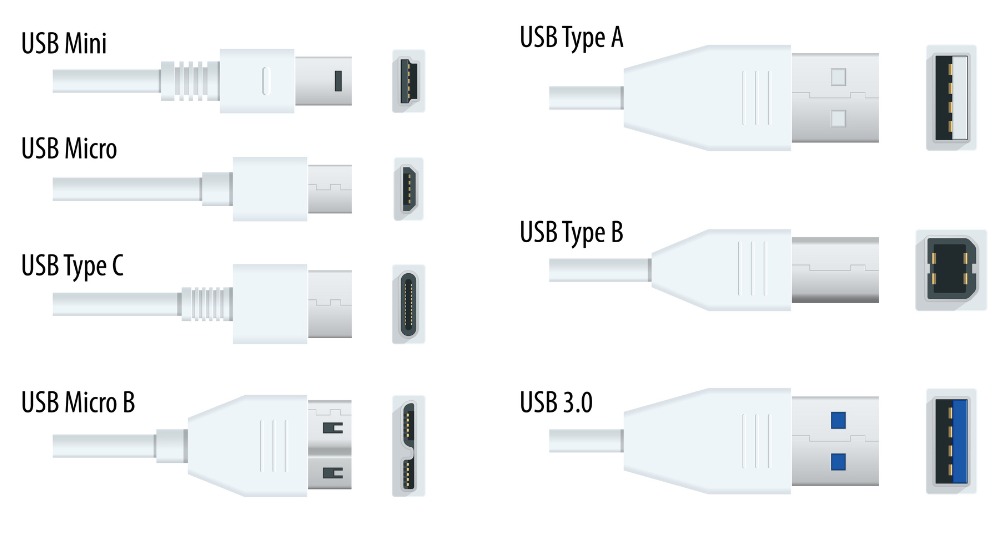
USB Cables:
USB cables are vital for connecting webcams to computers, and they come in several types, each with unique features.
Key Types of USB Cables:
- USB 2.0: Offers a data transfer rate of up to 480 Mbps, suitable for standard-definition video. It’s widely compatible and easy to use with plug-and-play functionality.
- USB 3.0: Provides faster speeds of up to 5 Gbps, ideal for high-definition video. It’s backward compatible with USB 2.0 devices and delivers better power.
- USB-C: Features a reversible design and supports data rates up to 10-20 Gbps. It can also deliver power and support video output, making it a versatile choice for modern setups.
Ethernet Cable:
Ethernet cables are essential for IP webcams, allowing them to connect to a network for remote access and monitoring. They provide a stable connection that is crucial for surveillance applications.
Features of Ethernet Cables:
- Network Connectivity: Enables cameras to communicate over the internet, allowing remote viewing.
- Power Over Ethernet (PoE): Some models can deliver power and data, simplifying installation.
- High Data Transfer Rates: Supports fast data transmission, ensuring smooth video streaming.
Coaxial Cable:
Coaxial cables are commonly used in traditional analog camera systems. They are known for their durability and ability to transmit video signals over long distances without losing quality.
Features of Coaxial Cables:
- Long-Distance Capability: Ideal for transmitting video signals over greater distances.
- Strong Signal Strength: Less prone to interference, ensuring clear video quality.
- Variety of Connectors: Typically uses BNC connectors, which are easy to connect and disconnect.
HDMI Cable:
While not commonly used directly with webcams, HDMI cables are important in broader video systems. They transmit high-definition video and audio from cameras or recorders to monitors.
Features of HDMI Cables:
- High-Definition Video: Supports high-quality video output for better viewing experiences.
- Single Cable Solution: Combines audio and video into one cable, reducing clutter.
- Widely Used in Systems: Commonly used in setups where high-quality video is essential.
What Type Of Cable4 Dowyse Web Cam Use – A Model-Specific Breakdown!
Let’s now explore the various Dowyse webcam models and the types of cables they use. Depending on the specific model, Dowyse webcams utilize different types of cables, each with its own advantages.
Dowyse Pro 4K Webcam:
The Dowyse Pro 4K is designed for high-resolution streaming and professional content creation. It utilizes a USB Type-C cable, which ensures fast data transfer essential for handling high-bandwidth tasks like 4K video streaming. The USB-C connection also supports higher power delivery, ensuring consistent performance during demanding sessions.
Dowyse StreamMaster:
The StreamMaster is tailored for streamers and gamers who require reliable video quality. This model uses a USB Type-A (USB 3.0) cable, supporting high-speed data transfer to guarantee smooth and uninterrupted video output. The USB 3.0 interface enhances the webcam’s ability to handle high-definition video with minimal lag.
Dowyse Essential HD Webcam:
The Essential HD webcam is a more budget-friendly option featuring a USB Type-A (USB 2.0) cable. It’s suitable for everyday video conferencing, though its data transfer speed is slower compared to newer USB standards. Despite this, it provides adequate performance for standard video calls and basic recording needs.
Dowyse Ultra-Wide Webcam:
With an ultra-wide field of view, the Ultra-Wide webcam uses a USB Type-C cable to manage higher data rates. This makes it well-suited for wide-angle video calls and large group meetings, ensuring clear and detailed video. The USB-C connection also supports a more stable and faster data transfer, which is crucial for capturing wide scenes effectively.
Dowyse Compact Webcam:
The Compact Webcam is designed for portability and uses a Micro-USB connector. This setup is sufficient for lower-resolution streaming and basic tasks, making it ideal for on-the-go use. Its compact size and lightweight design make it convenient for users who need a portable webcam solution.
Dowyse Conference 360:
The Conference 360 is intended for professional meetings and uses a proprietary cable. This unique design optimizes performance, but replacing the cable requires contacting Dowyse directly for official parts. The proprietary connection ensures specialized functionality that enhances its effectiveness in high-stakes business environments.
How To Identify The Right Cable For Your Dowyse Webcam?
If you’re not sure What Type Of Cable4 Dowyse Web Cam Use, here are some steps to help you identify the correct cable:
Check The User Manual:
Each Dowyse webcam comes with a user manual that specifies the cable type required for optimal performance. This is the easiest and most accurate way to determine the correct cable. The manual will also include diagrams and specifications to help you confirm the cable type.
Inspect The Cable Connector:
Examine the connector on your webcam and compare it to standard USB connectors, such as Type-A, Type-C, or Micro-USB. This visual comparison can help you identify the type of cable needed. Be sure to also check if the connector is specific to any particular model or feature.
Look For Labels:
Many cables have labels or markings indicating their type, such as “USB 3.0” or “USB-C.” These labels can be a quick way to identify the correct cable. Additionally, some cables may have brand or model information that corresponds with your Dowyse webcam.
Consult Dowyse Support:
If you’re still uncertain about the cable type, reach out to Dowyse’s customer support team for detailed guidance. They can provide information specific to your webcam model and ensure you get the right cable for your needs. Support can also offer troubleshooting tips if you’re facing connection issues.
Check The Product Listing:
When purchasing a new Dowyse webcam, review the product listing for detailed specifications on the cable type. Online retailers often include this information in the product description, helping you verify the cable type before buying.
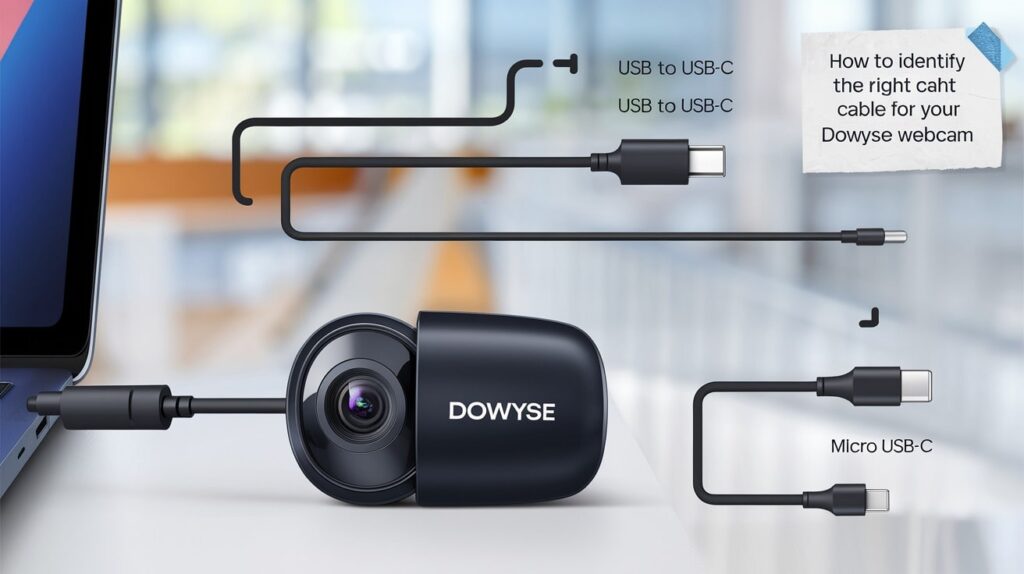
What Is The Difference In Quality Between Micro-Usb And Usb-C Cables For Webcams?
| Feature | Micro-USB | USB-C |
| Data Transfer Speed | Limited to 480 Mbps (USB 2.0) or up to 5 Gbps (USB 3.0) | Up to 10 Gbps (USB 3.1) or even 20 Gbps (USB 3.2) |
| Power Delivery | Limited to about 9 Watts | Can deliver up to 100 Watts, allowing faster charging |
| Durability | Generally less durable, with around 1,500 connect-disconnect cycles | More durable, rated for up to 10,000 cycles |
| Insertion Orientation | Must be inserted in the correct orientation | Reversible design allows insertion in any direction |
| Common Applications | Widely used in older smartphones and some cameras | Increasingly used in modern devices like laptops and smartphones |
The Impact Of Cable Choice On Webcam Performance – Need To Know!
Resolution And Frame Rates:
Higher-resolution webcams, especially those capable of 4K video, require a fast and stable data connection. Using an older USB 2.0 cable with a 4K-capable webcam can result in dropped frames, poor video quality, and lag.
Audio And Video Sync:
Poor-quality or incompatible cables can cause issues with audio-video sync, especially during live streaming or video conferencing. A high-speed cable such as USB 3.0 or USB-C ensures that both video and audio data are transmitted quickly and in sync.
Connection Stability:
Using the wrong or low-quality cable can lead to intermittent connections, where the webcam disconnects or struggles to maintain a stable signal during use. This is especially frustrating during important meetings or while streaming live content.
Dowyse Webcam Cable Pricing – Don’t Miss Out!
To assist you in making an informed choice for your Dowyse webcam purchase, we’ve put together a detailed pricing comparison of popular Dowyse webcam models along with their respective cables. Keep in mind that these prices are approximate and can vary based on the retailer and any ongoing promotions.
| Webcam Model | Cable Type | Price of Webcam | Price of Replacement Cable |
| Dowyse Pro 4K | USB-C | $129.99 | $19.99 |
| Dowyse StreamMaster | USB-A (3.0) | $89.99 | $14.99 |
| Dowyse Essential HD | USB-A (2.0) | $49.99 | $9.99 |
| Dowyse Ultra-Wide | USB-C | $149.99 | $24.99 |
| Dowyse Compact | Micro-USB | $39.99 | $7.99 |
| Dowyse Conference 360 | Proprietary | $199.99 | $29.99 |
What Are Common Troubleshooting Steps For Dowyse Webcam Cable Issues?
No Video Signal:
- Check Cable Connections: Ensure the cable is firmly connected to both the webcam and the computer. A loose connection can interrupt the video signal.
- Try Different Ports: Switch to another USB port on your computer to determine if the issue is with the specific port.
Intermittent Connection:
- Inspect Cable and Connectors: Look for any visible damage or wear on the cable and connectors. Damaged cables can cause unstable connections.
- Clean Connectors: Gently clean the connectors on both the webcam and the cable using a soft, dry cloth to remove any dust or debris.
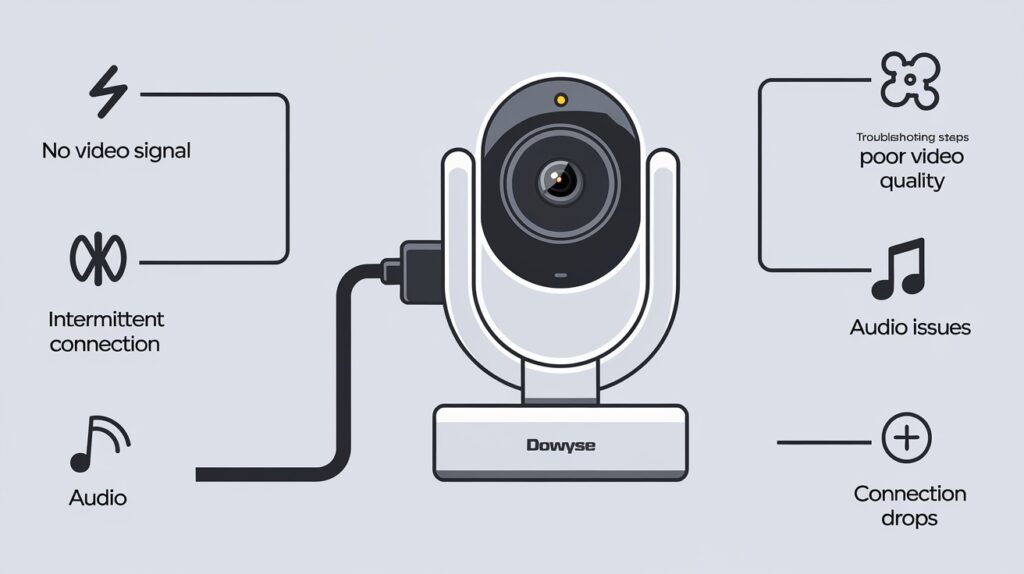
Poor Video Quality:
- Verify Cable Type: Ensure you are using the correct cable type for your Dowyse webcam model. An incompatible or lower-quality cable can affect video quality.
- Update Drivers: Make sure that your webcam drivers and any related software are up-to-date. Outdated drivers can impact performance.
Audio Issues:
- Check Audio Settings: Verify that your computer’s audio settings are correctly configured to use the webcam’s microphone.
- Test with Another Cable: If possible, try using a different cable to see if the issue persists, which might indicate a problem with the original cable.
Connection Drops:
- Examine for Physical Damage: Inspect the cable for any signs of physical damage, such as fraying or kinks, which can cause intermittent connectivity issues.
- Check for Interference: Ensure there are no other electronic devices causing interference near the cable or webcam, as this can impact connection stability.
FAQs:
Can I replace my Dowyse webcam cable with a generic cable?
Yes, but make sure the generic cable matches the specifications required by your Dowyse webcam. Using a generic cable that doesn’t meet these specs may lead to connectivity or performance issues. For optimal results, it’s often best to use the cable recommended by Dowyse.
What happens if I use the wrong cable with my Dowyse webcam?
Using the wrong cable can cause issues like poor video quality, unstable connections, or even complete failure to connect. The wrong cable might not provide adequate power or data transfer, leading to potential malfunction. Always use the correct cable type for reliable performance.
What are the typical lengths of Dowyse webcam cables?
Most Dowyse webcam cables are between 5 to 10 feet (1.5 to 3 meters) long, which provides flexibility for different setups. This length is generally sufficient for placing the webcam at a comfortable distance from your computer.
How do I know if my Dowyse webcam supports USB 3.0 or USB-C?
Check the product specifications in the user manual or on Dowyse’s website for the cable type your webcam supports. You can also inspect the connector: USB 3.0 typically has a Type-A connector, while USB-C has a smaller, reversible design. If uncertain, consult Dowyse customer support.
Is it necessary to use a USB-C cable for 4K webcams?
USB-C is often recommended for 4K webcams due to its higher data transfer rates. However, some 4K webcams may work with USB 3.0 if they can handle the required bandwidth. Using USB-C ensures optimal performance and future compatibility.
Conclusion:
Understanding what type of cable your Dowyse webcam uses is essential for ensuring optimal performance and compatibility. Whether your model uses USB-A, USB-C, or another type, the right cable can enhance video quality and connectivity.
Always refer to your webcam’s specifications or manual to choose the correct cable. Using the appropriate cable helps you avoid performance issues and ensures a smooth experience with your Dowyse webcam.

